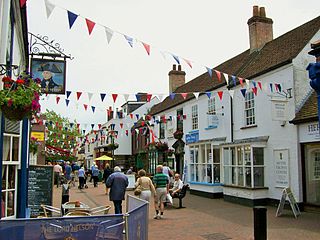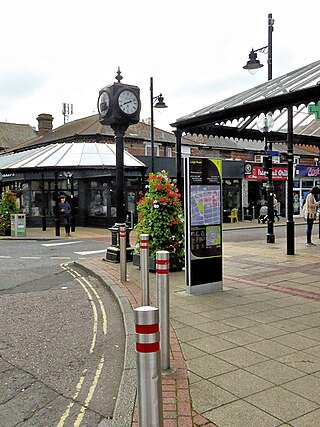
Hythe is a town in Hampshire, England. It is located by the shore of Southampton Water, and has a ferry service connecting it to Southampton. Hythe has a shopping area, a pier, and a marina for yachts.

The Borough of Eastleigh is a local government district with borough status in Hampshire, England. It is named after its main town of Eastleigh, where the council is based. The borough also contains the town of Hedge End along with several villages, many of which form part of the South Hampshire urban area.

Southampton Water is a tidal estuary north of the Solent and the Isle of Wight in England. The city of Southampton lies at its most northerly point, where the estuaries of the River Test and River Itchen meet. Along its salt marsh-fringed western shores lie the New Forest villages of Dibden, Hythe and Fawley, and the Fawley Refinery. On the slightly steeper eastern shore are the Southampton suburb of Weston, the villages of Netley and Hamble-le-Rice, and the Royal Victoria Country Park. To the south, Southampton Water enters the Solent between Calshot Spit and Hill Head.

Hamble-le-Rice, commonly known as Hamble, is a village and civil parish in the Borough of Eastleigh in Hampshire, England. It is best known for being a flying training centre during the Second World War and is a popular yachting location. The village and the River Hamble also featured in the 1980s BBC television series Howards' Way. The village centre, known as The Square, Hamble, has a more traditional English village aesthetic which differentiates it from the small industrial areas close to the village.

Holbury is a village in Hampshire, England. It is part of the parish of Fawley.

Warsash is a village in southern Hampshire, England, situated at the mouth of the River Hamble, west of the area known as Locks Heath and south of Sarisbury. Boating plays an important part in the village's economy, and the village has a sailing club. It is also home to the Warsash Maritime Academy, part of Southampton Solent University, which provides training for Merchant Navy Officers from around the world.

The Royal Victoria Hospital or Netley Hospital was a large military hospital in Netley, near Southampton, Hampshire, England. Construction started in 1856 at the suggestion of Queen Victoria but its design caused some controversy, chiefly from Florence Nightingale. Often visited by Queen Victoria, the hospital was extensively used during the First World War. It became the 28th US General Hospital during the invasion of mainland Europe in the Second World War. The main building – the world's longest building when it was completed – was entirely demolished in 1966, except for the chapel and former YMCA building, which still survive. The extensive outbuildings, which once occupied a vast acreage of land to the rear of the main building, finally succumbed in 1978. The site of the hospital can be seen and explored in Royal Victoria Country Park. The site had a railway station, which was connected by the Netley Hospital Branch Line.
Weston is a small suburb on the south-eastern side of Southampton, UK, predominantly built on the Weston Grove Estate formerly owned by the Chamberlayne family. It also includes the area that was previously the Barnfield Estate. Weston includes part of Mayfield Park, which was previously the Mayfield Estate. Weston is bounded by Woolston, Sholing, Netley and Southampton Water.

North Baddesley is a large village and civil parish in Hampshire, England. It is situated 3 mi (5 km) east of the town of Romsey and 6 mi (10 km) north of Southampton. It occupies an area of approximately 9.15 km2 (3.53 sq mi), and is home to a population of just over 10,000 people, reducing to 7,000 at the 2011 Census. It is located in the Test Valley; a river famous for trout fishing.

Sholing, previously Scholing, is a suburb on the eastern side of the city of Southampton, in the ceremonial county of Hampshire, England. It is located between the districts of Bitterne, Thornhill and Woolston.

The Port of Southampton is a passenger and cargo port in the central part of the south coast of England. The modern era in the history of the Port of Southampton began when the first dock was inaugurated in 1843. After the Port of Felixstowe, Southampton is the second largest container terminal in UK, with a handled traffic of 1.5 million twenty-foot equivalent units (TEU). It also handles cruise ships, roll-on roll-off, dry bulk, and liquid bulk.

Hound is a village and civil parish in the borough of Eastleigh in southern Hampshire, England. The parish encompasses the villages of Netley, Butlocks Heath and Old Netley, and includes such landmarks as Netley Castle and Netley Abbey. In the 2001 census, the parish had a headcount of 6,846 living in 2,928 households.

Mayfield Park is a recreational area straddling Woolston and Weston in Southampton, England. The stream that runs through the park is the boundary between the two districts of modern Southampton.
Abbeys and priories in Hampshire lists abbeys, priories, friaries or other monastic religious houses in Hampshire, England.
Tankerville Chamberlayne was a landowner in Hampshire and a member of parliament, serving the Southampton constituency three times, as an Independent and Conservative. He was deprived of his seat after the 1895 general election because of the indiscretion of one of his campaign workers and his having headed a procession which raised suspicion of having supplied beer to supporters. He subsequently raised the question of false electioneering statements in Parliament.

Cranbury Park is a stately home and country estate situated in the parish of Hursley, Winchester, England. It was formerly the home to Sir Isaac Newton and later to the Chamberlayne family, whose descendants continue to own and occupy the house and surrounding park and farmland in the 21st century. The house and park are not generally open to the public, although open days are occasionally held.

Thomas Dummer (1739–1781) was an English Member of Parliament for Newport (1765–1768), Yarmouth (1769–1774), Downton in Wiltshire (1774), Wendover in Buckinghamshire (1775–1780) and Lymington in Hampshire (1780–1781).
History of Woolston, suburb of Southampton, Hampshire.

Westwood Woodland Park is a 49.5-hectare (122-acre) Local Nature Reserve in Southampton in Hampshire. It is owned by Hampshire County Council and managed by Hampshire County Council and Southampton City Council. The site is split in two by a stream, the 'Tickleford Gully'. The park forms the boundary of Southampton and Netley.
















